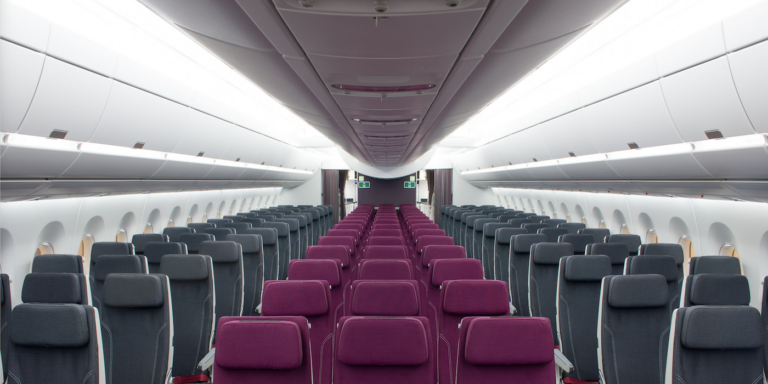Airbus knew its A350 XWB had to be a revolutionary aircraft from the design process onward, as discussions with operators of existing widebody jetliners revealed many were interested in something completely new. This spurred the company’s decision to develop a cabin interior the likes of which had never before been seen.
Airbus’ Executive Committee seized the opportunity by proposing what became known as the “chrysalis cabin.” Designers traditionally start work by looking at existing cabins and identifying evolutionary improvements that would add incremental benefits for passengers and airlines. The inspiration for the chrysalis cabin was the potential of new technologies to allow a break with the past, so discussions began with a blank sheet of paper.
“We saw no point in simply tweaking existing cabin designs when the aircraft itself was going to be completely new,” explains Kiran Rao, Airbus’ head of strategy. “The chance to offer customers a substantially better cabin as well as excellent performance, range and efficiency was too good to miss. After all, the quality of the cabin is what matters most of all to passengers.”
Older widebody jetliners are tapered at the front and back, but this places limitations on seat configuration and makes an aircraft feel narrow as passengers look along the cabin. Curved walls also reduce shoulder room in window seats, and for many passengers the view from these windows is quite limited. The chrysalis cabin was designed with no tapering at all between the doors, straighter walls and panoramic windows that are 50% bigger than those on the A330 – setting a new industry standard.
Dropping the floors allowed straighter walls, a change that also increased the feeling of spaciousness, made room for bigger overhead storage bins and meant that crew rest areas could be installed above the passenger deck. “The more seats on the passenger deck and the more cargo in the hold, the better,” Rao adds. “Putting the crew’s bunks above everything else increased the available revenue space even further.” Other proposals included LED lighting, 3D and ultra-HD ready in-flight entertainment, a flat floor and full connectivity.
Determined delivery
“When we saw the chrysalis cabin requirements that arrived from the Executive Committee, we were slightly stunned,” remembers Jochen Mueller, cabin supply module head of engineering. “We didn’t think it was actually possible and neither did some of our suppliers, but being engineers, we soon started thinking in terms of solutions.” The scale of the challenge led to a new way of working. Mueller believes that the key to the team’s successful delivery was their adoption of the requirement-based system, introduced for the first time with Airbus’ A350 XWB.
In the past cabin engineers had worked out exactly what they wanted and then asked suppliers to produce it. For the A350 XWB the process was changed. “Our suppliers became RSPs (risk sharing partners) and we trusted them much more, we let them work out the finer details as long as what they produced met our requirements,” says Mueller.
A prime example of this approach arose with the aircraft’s new LED lighting system, which had to be zonal, programmable and provide the full range of colours – but explaining how bright it should be was a problem. “We could have done a lot of research before giving exact specifications, but instead we said we wanted the rest rooms to be bright enough for passengers to put their make-up on and then left it to the lighting experts to achieve that,” Mueller explains.
Of course, careful, regular, systematic checks were essential to monitor progress, but showing faith in the ability of RSPs to deliver made fast work on the cabin possible.
A quick glance at the new cabin’s credentials confirms Mueller’s assessment. Air pressure and humidity levels are better while state-of-the-art in-flight entertainment (IFE) is delivered through larger, higher quality screens. Mood lighting can help passengers to avoid jet lag, changes to suit each phase of the flight and allows airlines to brand the interior by using colours against the white aircraft walls.
Despite the state-of-the-art IFE, the floor is flat and IFE boxes have been shrunk to have no impact on passengers’ feet. Overhead bins are larger, shoulder room is better and the lack of tapering makes the cabin feel more spacious. And the panoramic windows offer a noticeably better view. Even the hot beverage machines and ovens have their servicing needs monitored by a centralised computer system.
“Being presented with non-negotiable requirements is every engineer’s nightmare but our job was to overcome any problems,” says Mueller. “It took a few years, but with the help of our RSPs I think we did it.”





